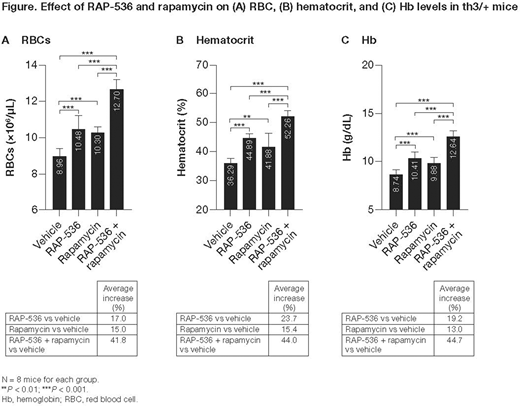Luspatercept, a fusion protein composed of a modified activin receptor type-2B (ActRIIB) and IgG1 Fc, is a novel erythroid maturation agent that has been shown to increase red blood cell (RBC) and hemoglobin (Hb) levels. Luspatercept binds to and sequesters several endogenous transforming growth factor-beta superfamily ligands, thereby diminishing Smad2/3 signaling. RAP-536, the murine analog of luspatercept, has been shown to induce erythroblast maturation and increase RBC, Hb, and hematocrit levels in wild-type (WT) mice and in murine disease models of beta-thalassemia and myelodysplastic syndromes. Previous studies have shown that rapamycin (sirolimus), an mTOR inhibitor, improved anemia in a mouse model of beta-thalassemia by activating the autophagy pathway.
In this study, rapamycin was tested in combination with RAP-536 by treating WT mice and th3/+ mice (a beta-thalassemia disease model; B6.129P2-Hbb-b1tm1Unc Hbb-b2tm1Unc/J) with vehicle, RAP-536 10 mg/kg twice weekly, rapamycin 4 mg/kg daily, or RAP-536 plus rapamycin for 2 weeks.
Single-agent dosing with either RAP-536 or rapamycin increased RBC, Hb, and hematocrit levels significantly compared with vehicle treatment in both WT and th3/+ mice (Figure). The percentage increase in RBC, Hb, and hematocrit levels upon RAP-536 or rapamycin administration was substantially higher in th3/+ mice than in WT mice. Interestingly, much higher and significant increases in RBC and Hb levels in both WT and th3/+ mice, and in hematocrit levels in th3/+ mice, were observed with RAP-536 plus rapamycin, when compared with the single agents. For example, in th3/+ mice, the increase in Hb levels compared with vehicle control was 19.2% with RAP-536 alone, 13.0% with rapamycin alone, and 44.7% with RAP-536 plus rapamycin (Figure). In th3/+ mice, RAP-536 plus rapamycin treatment also significantly reduced spleen enlargement compared with vehicle (P < 0.001). RAP-536 increased and rapamycin decreased overall reticulocyte levels and immature reticulocyte relative percentages in whole reticulocyte populations in the blood of WT mice, suggesting that RAP-536 and rapamycin have different mechanisms of action through which they increase RBC and Hb levels.
Altogether, these preclinical results provide a rationale for combining rapamycin, and potentially other mTOR inhibitors, with luspatercept to treat anemia associated with beta-thalassemia.
Acar:Bristol Myers Squibb: Ended employment in the past 24 months. Jupelli:Bristol Myers Squibb: Current Employment. MacBeth:Bristol Myers Squibb: Current Employment, Current equity holder in publicly-traded company. Schwickart:Bristol Myers Squibb: Current Employment, Current equity holder in publicly-traded company.
Author notes
Asterisk with author names denotes non-ASH members.


